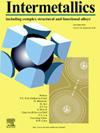[011]取向第四代镍基单晶高温合金1000℃低周疲劳行为及变形机制
IF 4.3
2区 材料科学
Q2 CHEMISTRY, PHYSICAL
引用次数: 0
摘要
第四代单晶高温合金具有优异的高温使用性能。本文系统研究了[011]取向第四代ni基单晶高温合金在1000℃下的低周疲劳行为和变形机制。该合金在应变幅为0.5%时表现出循环稳定行为。而在应变幅为0.7%和0.8%时,合金表现出循环硬化行为。在应变幅为0.5%时,氧化层的剥落导致裂纹萌生。当应变幅值增加到0.7%和0.8%时,裂纹萌生主要发生在铸孔附近。此外,在不同应变幅值下,滑移带在断口附近剪切了γ相和γ′相。循环硬化行为主要是由于形成了不同方向和不均匀位错网络的SFs。此外,弯曲位错和超位错的形成是导致循环软化的主要原因。位错运动现象导致了严重的塑性变形,从而降低了LCF寿命。本工作和实验数据对第四代单晶高温合金的工程应用具有指导意义。本文章由计算机程序翻译,如有差异,请以英文原文为准。
Low cycle fatigue behaviors and deformation mechanisms of the [011] oriented fourth-generation Nickel-based single crystal superalloy at 1000 °C
The fourth-generation single crystal superalloy has excellent service performance at high temperature. In this work, the low cycle fatigue behaviors and deformation mechanisms of the [011] oriented fourth-generation Ni-based single crystal superalloy was systematically investigated at 1000 °C. The alloy exhibited a cyclic stable behavior under strain amplitude of 0.5 %. However, under strain amplitude of 0.7 % and 0.8 %, the alloy exhibited a cycle hardening behavior. Afterwards, the crack initiation could be attributed to the exfoliation of the oxidation layers under strain amplitude of 0.5 %. As the strain amplitude increases to 0.7 % and 0.8 %, the crack initiation was mainly observed near the cast pores. Moreover, it could be seen that slip bands sheared both γ and γ′ phases in the vicinity of the fracture surface under different strain amplitudes. The cycle hardening behavior was attributed to the formation of SFs with different directions and inhomogeneous dislocation networks. In addition, the cycle softening behavior was attributed to the formation of bowing dislocations and super-dislocations. The phenomenon of dislocations movement led to the severe plastic deformation, thereby reducing the LCF life. This work and resulting experimental date guide the engineering application of the fourth-generation single crystal superalloy in the future.
求助全文
通过发布文献求助,成功后即可免费获取论文全文。
去求助
来源期刊

Intermetallics
工程技术-材料科学:综合
CiteScore
7.80
自引率
9.10%
发文量
291
审稿时长
37 days
期刊介绍:
This journal is a platform for publishing innovative research and overviews for advancing our understanding of the structure, property, and functionality of complex metallic alloys, including intermetallics, metallic glasses, and high entropy alloys.
The journal reports the science and engineering of metallic materials in the following aspects:
Theories and experiments which address the relationship between property and structure in all length scales.
Physical modeling and numerical simulations which provide a comprehensive understanding of experimental observations.
Stimulated methodologies to characterize the structure and chemistry of materials that correlate the properties.
Technological applications resulting from the understanding of property-structure relationship in materials.
Novel and cutting-edge results warranting rapid communication.
The journal also publishes special issues on selected topics and overviews by invitation only.
 求助内容:
求助内容: 应助结果提醒方式:
应助结果提醒方式:


